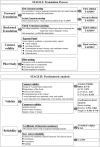Cultural Adaptation and Validation of the Attitude Scale for Pressure Injury Prevention Among Clinical Nurses
- PMID: 40414622
- PMCID: PMC12103941
- DOI: 10.1111/iwj.70682
Cultural Adaptation and Validation of the Attitude Scale for Pressure Injury Prevention Among Clinical Nurses
Abstract
To translate and validate psychometric analyses across different cultures. Pressure injuries are a concern in healthcare. Negative attitudes hamper prevention efforts, yet Taiwan lacks a reliable assessment tool. Translate the Pressure Injury Prevention Attitude Scale, originally developed by Moore and Price, into the Taiwanese version, verify the psychometric analysis, and evaluate clinical nurses' attitudes toward pressure injury prevention. Brislin's forward and backward translation, along with verification processes, were employed to ensure that the translated Taiwanese version is culturally and linguistically appropriate for Taiwan. Content validity was evaluated by a panel of seven experts specializing in pressure injury. Confirmatory factor analysis affirmed the validity of both positive and negative measures within the attitude scale items. A sample of 330 nurses from a regional teaching hospital participated in assessing the instrument's construct validity, internal consistency, and test-retest reliability. Data collection occurred between April and May 2021. The Attitudes Toward Pressure Injury Prevention-Taiwanese Version exhibited robust psychometric properties, demonstrating high item-level content validity and internal consistency as indicated by Cronbach's α. Additionally, it showed impressive test-retest reliability. Confirmatory factor analysis identified two distinct factors, reflecting positive and negative attitudes. The Attitudes Toward Pressure Injury Prevention Scale-Taiwanese Version effectively assesses nurses' attitudes towards PI prevention in Taiwan. It also informs future research on the relationship between attitudes, knowledge and clinical performance. The Attitudes Toward Pressure Injury Prevention-Taiwanese Version serves as a valuable tool for assessing nurses' attitudes in Taiwan, enhancing preventive measures and patient care. Managers and educators can utilize attitude measures on pressure injury prevention to shape training strategies.
Keywords: attitude; cross culture; nurse; pressure injury; prevention; psychometric properties; validation.
© 2025 The Author(s). International Wound Journal published by Medicalhelplines.com Inc and John Wiley & Sons Ltd.
Conflict of interest statement
The authors declare no conflicts of interest.
Figures

Similar articles
-
Chinese Version of the Career Adapt-Abilities Scale for Clinical Nurses: A Translation and Psychometric Validation Study.J Nurs Manag. 2024 Nov 27;2024:8198854. doi: 10.1155/jonm/8198854. eCollection 2024. J Nurs Manag. 2024. PMID: 40224766 Free PMC article.
-
Attitudes of Spanish Nurses towards Pressure Injury Prevention and Psychometric Characteristics of the Spanish Version of the APuP Instrument.Int J Environ Res Public Health. 2020 Nov 18;17(22):8543. doi: 10.3390/ijerph17228543. Int J Environ Res Public Health. 2020. PMID: 33217957 Free PMC article.
-
Cross-cultural validation and psychometric testing of the French version of the TeamSTEPPS teamwork perceptions questionnaire.J Health Organ Manag. 2024 Aug 29;38(6):923-941. doi: 10.1108/JHOM-01-2023-0004. J Health Organ Manag. 2024. PMID: 39198954
-
Do we still need to assess nurses' attitudes towards pressure ulcer prevention? A systematic review.J Wound Care. 2019 Dec 2;28(12):795-806. doi: 10.12968/jowc.2019.28.12.795. J Wound Care. 2019. PMID: 31825774
-
Development and psychometric evaluation of the Attitudes Towards Recognising Early and Noticeable Deterioration (ATREND) scale.J Clin Nurs. 2023 Jun;32(11-12):2684-2699. doi: 10.1111/jocn.16350. Epub 2022 May 8. J Clin Nurs. 2023. PMID: 35527356 Review.
References
-
- Cox J., Edsberg L. E., Koloms K., and VanGilder C. A., “Pressure Injuries in Critical Care Patients in US Hospitals: Results of the International Pressure Ulcer Prevalence Survey,” Journal of Wound, Ostomy, and Continence Nursing 49, no. 1 (2022): 21–28, 10.1097/won.0000000000000834. - DOI - PMC - PubMed
-
- Gefen A., Kolsi J., King T., Grainger S., and Burns M., “Modelling the Cost‐Benefits Arising From Technology‐Aided Early Detection of Pressure Ulcers,” Wounds International 11, no. 1 (2020): 12–17.
-
- Graves N., Phillips C., and Harding K., “A Narrative Review of the Epidemiology and Economics of Chronic Wounds,” British Journal of Dermatology 187, no. 2 (2022): 141–148. - PubMed
Publication types
MeSH terms
LinkOut - more resources
Full Text Sources
Medical
Research Materials
Miscellaneous

